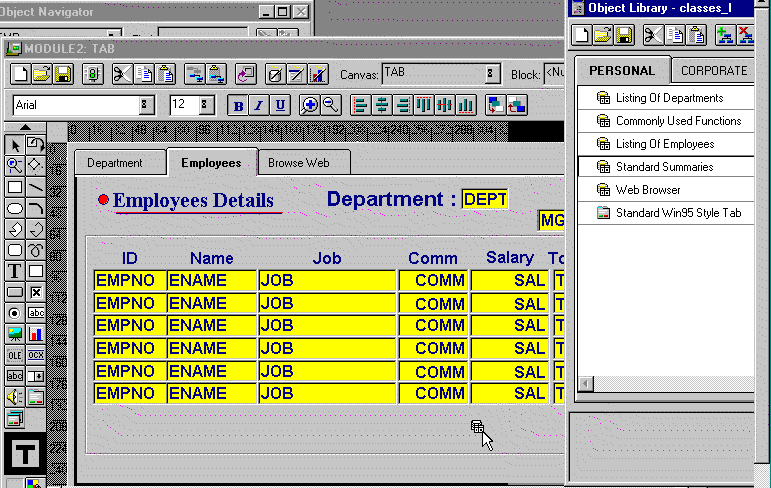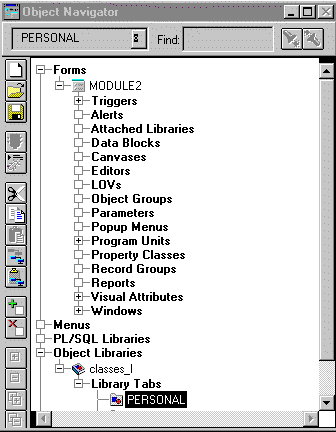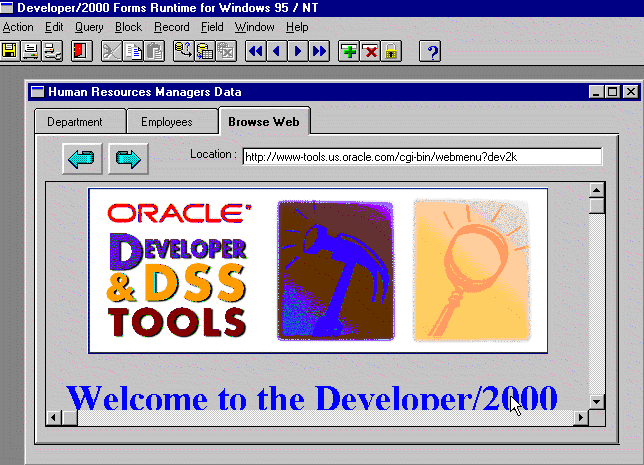
Oracle Developer/2000 Release 2
Productivity
Developer/2000 incorporates an integrated set of builders (Fig 1) for creating forms, reports, charts, queries, database objects and procedures. These components use powerful declarative capabilities to create applications from database definitions without writing a single line of code.

Fig 1 Developer2000 Architecture
Developer/2000 sets new ease-of-use and productivity standards for client/server and web development through the use of rapid application design (RAD) techniques, object orientation, built-in computer-based training, and a unified client, application server and database server architecture.

Fig 2 Developer2000 form builder wizard
The Developer/2000 interface consists of a powerful and easy-to-use combination of object browsers, tabbed dialogs, property palettes, and a WYSIWYG GUI interface. Applications are quickly created using the re-entrant wizards

Fig 3 Wizard based interface
or through inheritance of reusable components from the Object Library.

Fig 4 Using the object library
Organizational standards are easily applied through customizable application templates and default settings for each object. Industrial-strength reports are modified interactively using the intuitive live data previewer in the report builder. Extending Developer/2000 applications with client and server-based logic is easy using the Procedure Builder, a unified client and server PL/SQL(tm) editing and debugging environment. Developers also have the option of generating complete Developer/2000 applications directly from models in Designer/2000.
Developer/2000 offers an environment for development teams of all sizes. The integrated Project Builder manages all application and external components, such as multimedia content, and enables the components to be opened in the appropriate tool. The Project Builder also facilitates easy deployment of completed applications by zipping components into a single file. Configuration management, including check-in, check-out, version labeling, and difference reporting, is provided through interfaces to popular source and version-control packages.
Scalability
Scalability comes easily to Developer/2000 developers. It's inherent in the multi-tiered architecture of the product. It's explicit in the unparalleled support for server functionality, such as array DML, database cursors, bind variables, savepoints, and result sets. It's definitive in the drag-and-drop client/server object partitioning which reduces network traffic between client and server to a single round-trip. And it's evident in the embedded features that allow Developer/2000 customers to scale from 5 to 5,000 users, from megabytes to gigabytes of data, and from decision-support to complex OLTP applications. Developer/2000's flexible multi-tier architecture supports Oracle7(tm) application servers or third-party application servers such as TP monitors, ensuring scalability from desktop to the enterprise.

Fig 5 Developer2000 Object Navigator
Openness
Standards-based interaction between Developer/2000 and other applications and tools is enabled through OCX/ActiveX controls, OLE (Object Linking and Embedding), and DDE (Dynamic Data Exchange). Support for a variety of multimedia formats is complemented by an open API, giving developers the flexibility to extend Developer/2000 applications and integrate other components into them.
Developer/2000 not only offers the best integration with Oracle databases, but also provides transparent access to all major databases including Rdb, SQL Server, Informix, Sybase, and DB/2. Database access is provided through direct database drivers as well as through the Developer/2000 API and Oracle Gateways.
A number of interfaces to third-party products are available through members of the Open Tools Initiative. These interfaces include configuration management tools, testing tools, CASE and modeling tools, workflow engines, transaction processing (TP) monitors, and many others.

Fig 6 Developer2000 runform environment
Web Publishing
The power and flexibility of Developer/2000's report builder is available to developers to deploy the same reports in a client/server environment as well as on the Web. Reports generated for the web in HTML or Adobe's pdf format provide a degree of presentation quality and precision that is critical for publishing enterprise-wide information. The drill-down capabilities, embedded links to other Web pages, integrated charts and automatically generated tables-of-contents in web reports, ensure a productive and intuitive environment for users to navigate through corporate information.
Deploy information on demand with dynamically generated reports that contain accurate and current corporate data using the Developer/2000 Reports Server, freeing up client resources in the process. Alternatively schedule reports to run and refresh periodically, eliminating redundant database processing.
Web Transactions
The challenge for organizations is to leverage the benefits of the Web, such as lower cost of deployment, while leveraging and maintaining investments in client/server applications. Web Developer/2000 provides the answer through technology that delivers the benefits of client/server and the Web in a single application. Web Developer/2000 employs Java, the emerging standard for Web applications, for the application user interface while utilizing the powerful Developer/2000 processing engine on an application server, to handle events and interact with the database. Client/server applications run unchanged in any Java-aware Web browser (including the Network Computer), and without the need to install runtime or application software on any client. Developers can leverage all the GUI and transaction processing benefits of client/server while eliminating deployment and maintenance costs through an approachable Web interface, all without writing any code or learning any new languages.
Summary
Developer/2000 lead the second generation client/server revolution with the first scalable development tool. Developer/2000 Release 2 extends that advantage with the most approachable development environment, even better scalability, and the unmatched ability to deploy complete applications, unchanged, on all major GUI platforms, character mode, and the Web.
Oracle Corporation is the world's largest supplier of software for information management, and the world's second-largest software company. With annual revenues of more than $3.5 billion, the company offers its database, tools, and application products, along with related consulting, education, and support services, in more than 90 countries around the world.
Oracle is a registered trademark, and Enabling the Information Age, Oracle7, Designer/2000, Developer/2000, Procedure Builder, Oracle Open Gateway, and PL/SQL are trademarks of Oracle Corporation.
All other company and product names mentioned are used for identification purposes only, and may be trademarks of their respective owners.
Copyright (c) 1996, Oracle Corporation
All Rights Reserved
Printed in the U.S.A.
0000.0696.?K
Part#: 00000